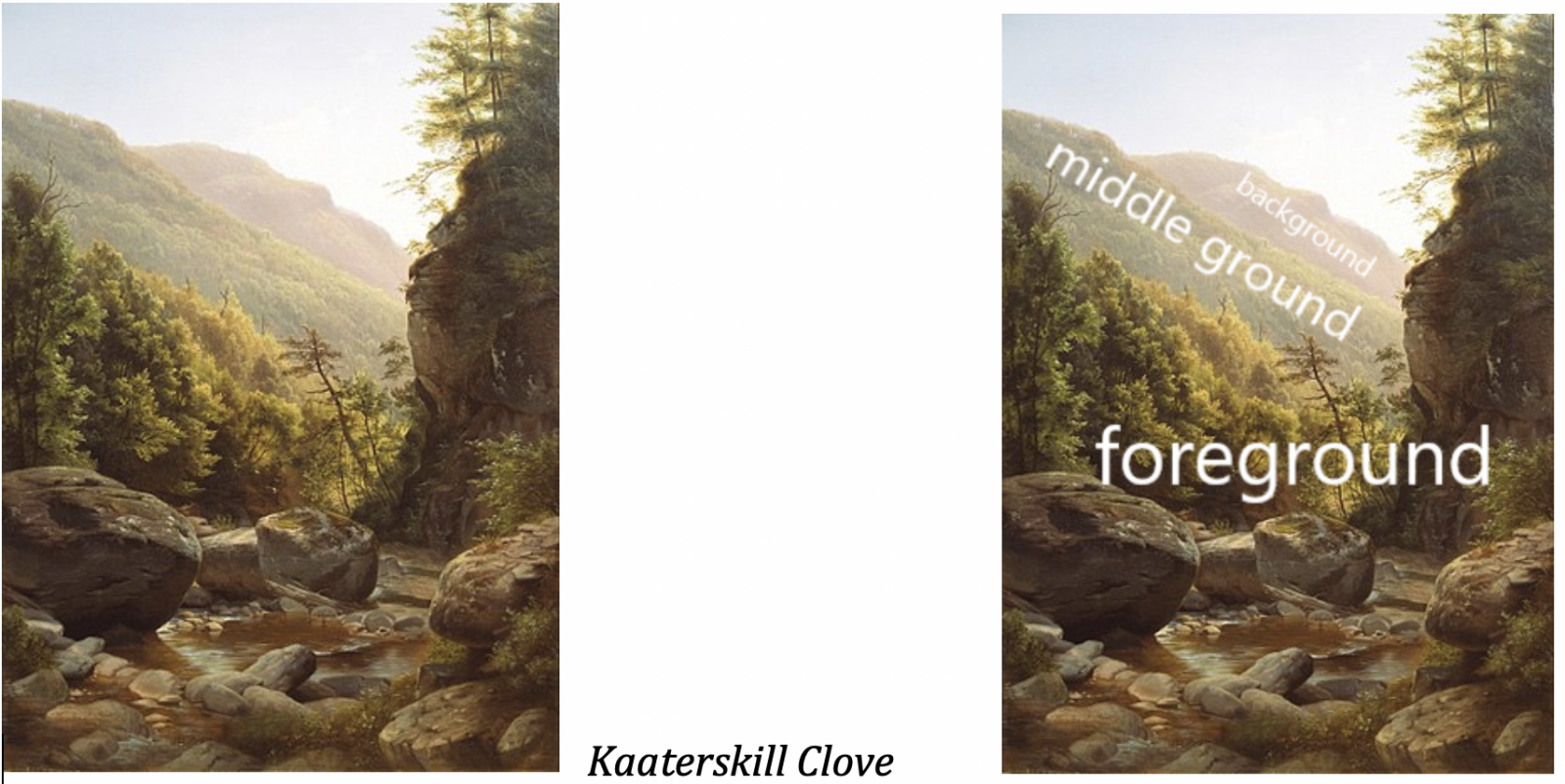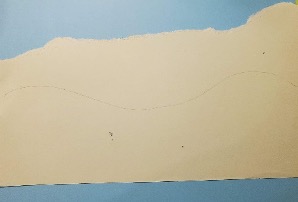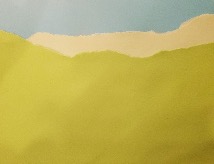Students will create a ripped paper collage demonstrating atmospheric perspective. Recommended for 4th Graders.
Color: the visible range of reflected light.
Form: a 3-dimensional figure that exists in space instead of flat on paper.
Space: a two-dimensional (flat/height and width) area enclosed by a line. Real space contains three dimensions: height, width and depth. An illusion of depth can be created in two-dimensional art formats, using certain techniques.
Value(Hue/Shade/Tint): Color (Hue) and variations of the color. Shades are color+black, tints are color+white. Muted colors have gray added. the lightness and darkness of a line, shape, or form; a measure of relative lightness and darkness. One way to express this is the use of hues, shades and tints.
Movement: How the artist makes the viewer’s eye move around the composition. In this lesson, the viewer’s eye is moved into the ‘distance.’
Atmospheric Perspective: the way things look differently if they are further away: in the foreground, colors are warmer and more intense and darker, crisper shades; in the distance, the details disappear, colors appear cooler and less intense, and values lighten and fade.
Background, Middle Ground & Foreground: Within the picture plane, objects that are closest are in the foreground, farthest from the horizon line. Objects that are farthest are in the background, closest to the horizon line. Middle ground is somewhere in between the 2.
Collage: a way of making a work of art by gluing different objects, materials, and textures to a surface. In this lesson it’s paper glued to paper.
Craftsmanship: A way of working that includes following directions, demonstrates neatness and the proper use of tools.
Gradation: a gradual changing from one color hue, or shade, or texture to another. Space, distance, atmosphere, and curved or rounded ‘forms’ are some of the visual effects created with gradation.
Horizon Line: A horizontal line where the land (or sea) ’meets’ the sky. It is the most distant spot we can see.
Overlapping: A technique to create depth in a 2-dimensional image. When shapes overlap, the partially obscured one appears to move back into the distance.

Harriet Cany Peale was born in 1799 at a time when women artists were not allowed into important art academies. Not much is known about her early art, but she was taught by Rembrandt Peale who she eventually married. The Peale family was renowned for its talented artists. Harriet continued to paint and exhibit after her marriage, which was unusual for the time. She often made copies of her husband’s paintings but also created impressive landscapes, portraits and still-life. She is part of what is known as the Hudson River School.
Hudson River School: not the name of a school but a group of landscape painters in the United States from 1825-1870 (including Harriet Cany Peale, T. Cole and J. Kensett, examples above, as well as Thomas Moran and Albert Bierstadt). Paintings from the early years of this time usually portray the Hudson River Valley and surrounding areas. Later paintings depicted scenes from the west and were often the public’s first glimpse of those wild areas. The Hudson River school was strongly nationalistic with the grand portrayals of America’s landscape and also the artists wanted their own style. The Hudson River School helped shape the perception and culture of America and is sometimes called America’s first art movement.
Gather materials listed above. Prepare images to show students. Have an example of the lesson.
How do landscapes appear in nature? (very different kinds, but always with a horizon line in the distance, change in lighting as we look towards it).
Have you seen the phenomenon where mountains in the distance appear to be a lighter tone? The atmosphere(clouds, mist, sun) is affecting the way the light hits objects so we see color differently.
How are the trees different in the foreground, middle ground and background in Harriet Cany Peale’s Kaaterskill Clove? (As they recede into the distance, they lose their crisp colors, shadows, details, and edges. The ones furthest away are hard to see individually, but more as a group.)
Students will:




.png)
Optional: Add details with paint or oil pastel in the foreground, if desired. Details should be darker and larger in the foreground than the rest of the landscape.
Lesson written by Rachelle Roberts. Harriet Cany Peale. 31 Mar. 2020, https://en.wikipedia.org/wiki/Harriet_Cany_Peale. Galleries, Roughton. Harriet Cany Peale. www.roughtongalleries.com/Harriet-Peale.htm. Hudson River School. 20 Apr. 2019, www.hisour.com/hudson-river-school-35812/. The Editors of Encyclopaedia Britannica. “Hudson River School.” Encyclopædia Britannica, Encyclopædia Britannica, Inc., 30 May 2018, www.britannica.com/art/Hudson-River-school. The Grand Women Artists of the Hudson River School. 20 July 2010, www.smithsonianmag.com/arts-culture/the-grand-women-artists-of-the-hudson-river-school-1911058/. Kiely, Alexandra. Female Painters of the Hudson River School, Part Two. 7 Feb. 2018, http://www.dailyartmagazine.com/female-painters-hudson-river-school-part-two/. “Kaaterskill Clove.” Wikimedia Commons, 01 Jan. 1858, https://commons.wikimedia.org/wiki/File:Kaaterskill_Clove_by_Harriet_Cany_Peale_1858.jpg.
21st Century Thinking Skills
Thinking flexibly, persisting, questioning, creating, innovating, listening with empathy, taking responsible risks, observing, making connections, visualizing, sequencing, predicting, comparing/contrasting, determining main idea, finding evidence, problem solving, cause and effect, determining point of view, decision making.
Washington State Learning Standards
(VA:Cr2.1.4) a. Explore and invent art-making techniques and approaches.
(VA:Cr2.2.4) a. When making works of art, utilize and care for materials, tools, and equipment in a manner that prevents danger to oneself and others.
(VA:Cr2.3.4) a. Document, describe, and represent regional constructed environments.
(VA:Cr3.1.4) a. Revise artwork in progress on the basis of insights gained through peer discussion. This happens if you share out about students’ choices of craftsmanship during the lesson.
(VA:Re7.2.4) a. Analyze components in visual imagery that convey messages. This happens when you explain how to create the illusion of depth in a 2-dimensional picture plane.
(VA:Re8.1.4) a. Interpret art by referring to contextual information and analyzing relevant subject matter, characteristics of form, and use of media.
(VA:Re9.1.4) a. Apply one set of criteria to evaluate more than one work of art.
(VA:Cn11.1.4) a. Through observation, infer information about time, place, and culture in which a work of art was created.
Arts Integration Opportunities
Physical/occupational therapy.
Please note: These lesson plans are intended for non-profit use only. Use of these plans for commercial purposes should give attribution to the Issaquah Schools Foundation and be accompanied by a nominal donation at www.isfdn.org/donate. Thank you.
Fueling Success for Every Student, Every School